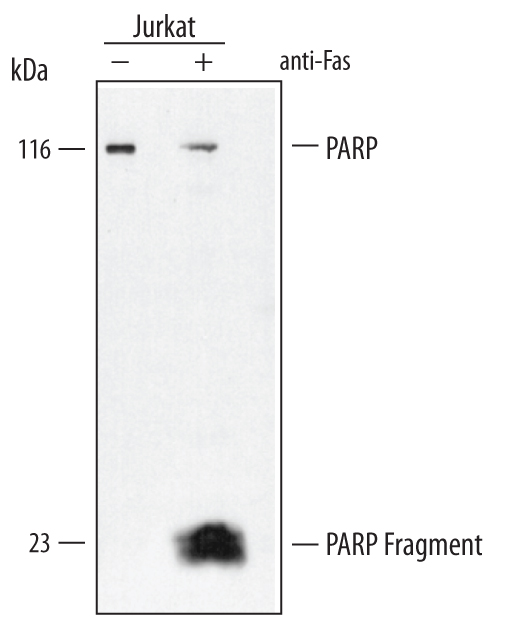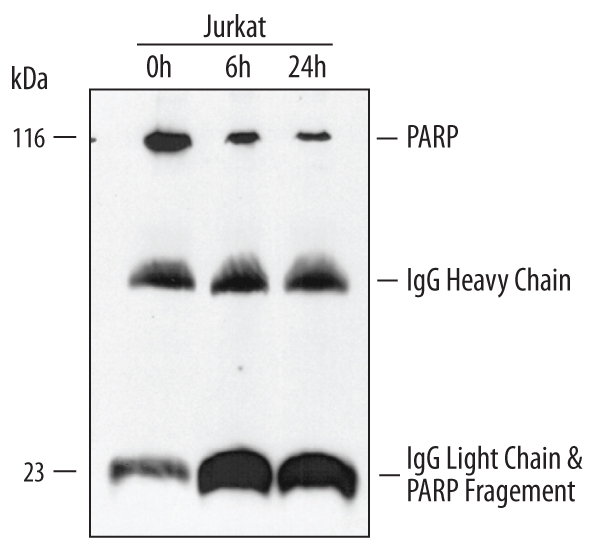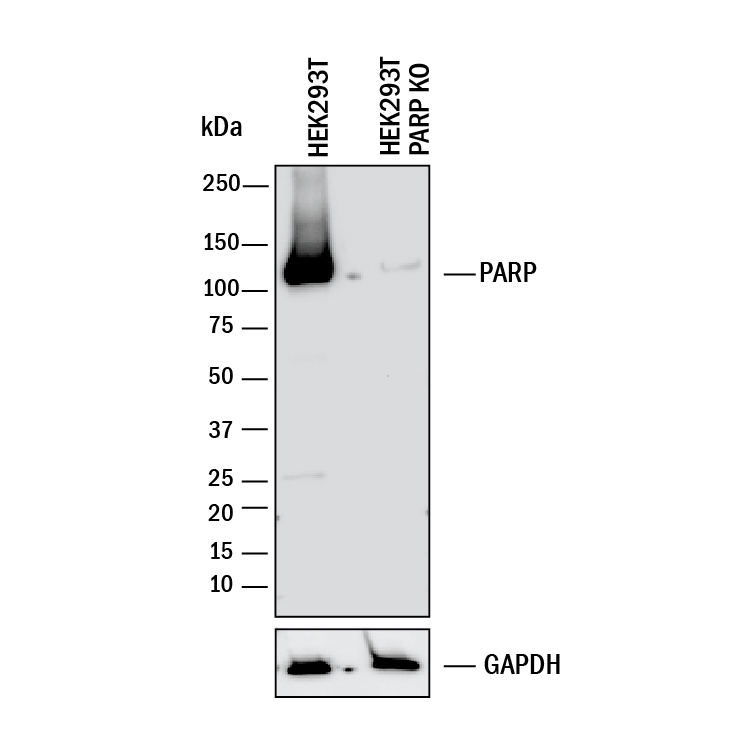Human/Mouse PARP Antibody Summary
Val71-Pro329
Accession # NP_031441
Applications
Please Note: Optimal dilutions should be determined by each laboratory for each application. General Protocols are available in the Technical Information section on our website.
Scientific Data
 View Larger
View Larger
Detection of Human PARP by Western Blot. Western blot shows lysates of Jurkat human acute T cell leukemia cell line untreated (-) or treated (+) with 200 ng/mL anti-Fas for 24 hours. PVDF membrane was probed with 0.4 µg/mL of Goat Anti-Human/Mouse PARP Affinity-purified Polyclonal Antibody (Catalog # AF-600-NA) followed by HRP-conjugated Anti-Goat IgG Secondary Antibody (Catalog # HAF109). A specific band was detected for PARP at approximately 116 kDa (as indicated). This experiment was conducted under reducing conditions and using Immunoblot Buffer Group 2.
 View Larger
View Larger
PARP in HeLa Human Cell Line. PARP was detected in immersion fixed HeLa human cervical epithelial carcinoma cell line using Goat Anti-Human/Mouse PARP Antigen Affinity-purified Polyclonal Antibody (Catalog # AF-600-NA) at 1 µg/mL for 3 hours at room temperature. Cells were stained using the NorthernLights™ 557-conjugated Anti-Goat IgG Secondary Antibody (red; Catalog # NL001) and counterstained with DAPI (blue). Specific staining was localized to nuclei. View our protocol for Fluorescent ICC Staining of Cells on Coverslips.
 View Larger
View Larger
Detection of Human PARP by Simple WesternTM. Simple Western lane view shows lysates of Jurkat human acute T cell leukemia cell line, loaded at 0.2 mg/mL. A specific band was detected for PARP at approximately 122 kDa (as indicated) using 5 µg/mL of Goat Anti-Human/Mouse PARP Antigen Affinity-purified Polyclonal Antibody (Catalog # AF-600-NA) followed by 1:50 dilution of HRP-conjugated Anti-Goat IgG Secondary Antibody (Catalog # HAF109). This experiment was conducted under reducing conditions and using the 12-230 kDa separation system.
 View Larger
View Larger
Immunoprecipitation of Human PARP. Jurkat human acute T cell leukemia cell line was treated with apoptosis inducer anti-Fas for the indicated times. PARP was immunoprecipitated from cell lysates (1 - 2 x 106cells) following incubation with 5 µg Goat Anti-Human/Mouse PARP Antigen Affinity-purified Polyclonal Antibody (Catalog # AF-600-NA) for overnight at 4 °C. PARP-antibody complexes were absorbed using Protein G expressing Staph cells (Sigma). Immunoprecipitated PARP was detected by Western blot using 0.4 µg/mL Goat Anti-Human/Mouse PARP Antigen Affinity-purified Polyclonal Antibody (Catalog # AF-600-NA). View our recommended buffer recipes for immunoprecipitation.
 View Larger
View Larger
Western Blot Shows Human PARP Specificity by Using Knockout Cell Line. Western blot shows lysates of HEK293T human embryonic kidney parental cell line and PARP knockout HEK293T cell line (KO). PVDF membrane was probed with 0.4 µg/mL of Goat Anti-Human/Mouse PARP Antigen Affinity-purified Polyclonal Antibody (Catalog # AF-600-NA) followed by HRP-conjugated Anti-Goat IgG Secondary Antibody (Catalog # HAF017). A specific band was detected for PARP at approximately 120 kDa (as indicated) in the parental HEK293T cell line, but is not detectable in knockout HEK293Tcell line. GAPDH (Catalog # AF5718) is shown as a loading control. This experiment was conducted under reducing conditions and using Immunoblot Buffer Group 1.
Reconstitution Calculator
Preparation and Storage
- 12 months from date of receipt, -20 to -70 °C as supplied.
- 1 month, 2 to 8 °C under sterile conditions after reconstitution.
- 6 months, -20 to -70 °C under sterile conditions after reconstitution.
Background: PARP
PARP, Poly [ADP-ribose] polymerase 1 (PARP1), is a component of a base excision repair (BER) complex, containing at least XRCC1, PARP2, POLB and LRIG3. Widely expressed. Expression is correlated with proliferation, with higher levels occurring during early fetal development and organogenesis and in the highly proliferative cell compartments of adult. Expressed in B-cells that have been induced to switch to various Ig isotypes. PARP interacts with the DNA polymerase alpha catalytic subunit POLA1; this interaction functions as part of the control of replication fork progression.
Product Datasheets
Citations for Human/Mouse PARP Antibody
R&D Systems personnel manually curate a database that contains references using R&D Systems products. The data collected includes not only links to publications in PubMed, but also provides information about sample types, species, and experimental conditions.
6
Citations: Showing 1 - 6
Filter your results:
Filter by:
-
Metabolite Profile and In Vitro Beneficial Effects of Black Garlic (Allium sativum L.) Polar Extract
Authors: P Bontempo, P Stiuso, S Lama, A Napolitano, S Piacente, L Altucci, AM Molinari, L De Masi, D Rigano
Nutrients, 2021-08-13;13(8):.
Species: Human
Sample Types: Cell Lysates
Applications: Western Blot -
Specific Effects of Trabectedin and Lurbinectedin on Human Macrophage Function and Fate-Novel Insights
Authors: A Povo-Retan, M Mojena, AB Stremtan, VB Fernández-, A Gómez-Sáez, C Nuevo-Tapi, JM Molina-Gui, J Avendaño-O, JM Cuezva, E López-Coll, JF Martínez-L, L Boscá
Cancers (Basel), 2020-10-20;12(10):.
Species: Human
Sample Types: Cell Lysates
Applications: Western Blot -
Comparative Phytochemical Characterization, Genetic Profile, and Antiproliferative Activity of Polyphenol-Rich Extracts from Pigmented Tubers of Different Solanum tuberosum Varieties
Authors: L De Masi, P Bontempo, D Rigano, P Stiuso, V Carafa, A Nebbioso, S Piacente, P Montoro, R Aversano, V D'Amelia, D Carputo, L Altucci
Molecules, 2020-01-06;25(1):.
Species: Human
Sample Types: Cell Lysat
Applications: Western Blot -
Nuclear-translocated Glyceraldehyde-3-phosphate Dehydrogenase Promotes Poly(ADP-ribose) Polymerase-1 Activation during Oxidative/Nitrosative Stress in Stroke.
Authors: Nakajima H, Kubo T, Ihara H, Hikida T, Danjo T, Nakatsuji M, Shahani N, Itakura M, Ono Y, Azuma Y, Inui T, Kamiya A, Sawa A, Takeuchi T
J Biol Chem, 2015-04-16;290(23):14493-503.
Species: Human
Sample Types: Cell Lysates
Applications: Western Blot -
Dual targeting of HER2-positive cancer with trastuzumab emtansine and pertuzumab: critical role for neuregulin blockade in antitumor response to combination therapy.
Authors: Phillips G, Fields C, Li G, Dowbenko D, Schaefer G, Miller K, Andre F, Burris H, Albain K, Harbeck N, Dieras V, Crivellari D, Fang L, Guardino E, Olsen S, Crocker L, Sliwkowski M
Clin Cancer Res, 2013-10-04;20(2):456-68.
Species: Human
Sample Types: Cell Lysates
Applications: Western Blot -
Nuclear localization of Survivin renders HeLa tumor cells more sensitive to apoptosis by induction of p53 and Bax.
Authors: Temme A, Rodriguez JA, Hendruschk S, Gunes S, Weigle B, Schakel K, Schmitz M, Bachmann M, Schackert G, Rieber EP
Cancer Lett., 2006-11-07;250(2):177-93.
Species: Human
Sample Types: Cell Lysates
Applications: Western Blot
FAQs
No product specific FAQs exist for this product, however you may
View all Antibody FAQsReviews for Human/Mouse PARP Antibody
Average Rating: 4.5 (Based on 2 Reviews)
Have you used Human/Mouse PARP Antibody?
Submit a review and receive an Amazon gift card.
$25/€18/£15/$25CAN/¥75 Yuan/¥2500 Yen for a review with an image
$10/€7/£6/$10 CAD/¥70 Yuan/¥1110 Yen for a review without an image
Filter by:
Antibody was printed on custom arrays and incubated with fluorescently labeled human EDTA plasma



